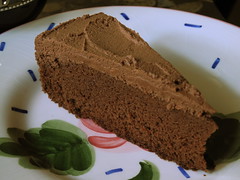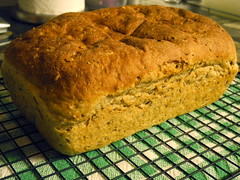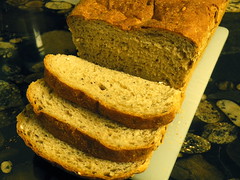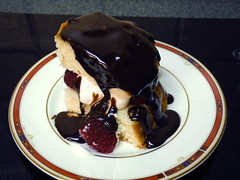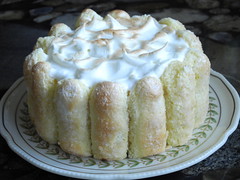 I was traveling over Thanksgiving, which made my cake-of-the-week for the Heavenly Cake Bakers switch from a centerpiece dessert for the big meal to a half-size version stuck in at the tail end of the weekend. That's a pity, because this is a lovely party (or holiday) dessert. Even better, it can be completely made ahead of time and frozen for up to 3 weeks. I'm making notes for some future occasion--this cake will be made again. Another advantage is that the cake can be made in stages, and I used that to squeeze it in after returning from my Thanksgiving trip. (The Folks Next Door and I went to older brother's house in North Carolina. We carried up the cranberry-orange relish and the squash-cheese casserole and I helped with some cooking and made the turkey chowder while there, but it was nice to not be a principal cook for the big meal for a change.)
I was traveling over Thanksgiving, which made my cake-of-the-week for the Heavenly Cake Bakers switch from a centerpiece dessert for the big meal to a half-size version stuck in at the tail end of the weekend. That's a pity, because this is a lovely party (or holiday) dessert. Even better, it can be completely made ahead of time and frozen for up to 3 weeks. I'm making notes for some future occasion--this cake will be made again. Another advantage is that the cake can be made in stages, and I used that to squeeze it in after returning from my Thanksgiving trip. (The Folks Next Door and I went to older brother's house in North Carolina. We carried up the cranberry-orange relish and the squash-cheese casserole and I helped with some cooking and made the turkey chowder while there, but it was nice to not be a principal cook for the big meal for a change.)  Before I left, I tackled the ladyfingers. These can probably be bought somewhere in Atlanta, though I've never noticed them in the stores. (I suspect that's because I've never looked.) I found them surprisingly easy to make. I did start by watching Rose's video on YouTube as a warm-up for piping ladyfingers, and that was very helpful in figuring out the cookbook instructions on drawing guidelines for the piping. My finished ladyfingers were a little undersized as I didn't have a pastry tube quite as large as the 3/4" specified (and I didn't squeeze my pastry bag as much as Rose did in the video), but that is all to the good as I planned to use them for two half-sized cakes: this week's Lemon Canadian Crown, and Tiramisù. I didn't even have as much trouble as I expected with the piping, and by the time my ladyfingers were baked, they looked, well, not like store-bought, but pretty darn good. Once baked and cooled, I wrapped the ladyfingers and my 6" disk (for the cake base) up in heavy-duty plastic wrap and popped them all into the freezer.
Before I left, I tackled the ladyfingers. These can probably be bought somewhere in Atlanta, though I've never noticed them in the stores. (I suspect that's because I've never looked.) I found them surprisingly easy to make. I did start by watching Rose's video on YouTube as a warm-up for piping ladyfingers, and that was very helpful in figuring out the cookbook instructions on drawing guidelines for the piping. My finished ladyfingers were a little undersized as I didn't have a pastry tube quite as large as the 3/4" specified (and I didn't squeeze my pastry bag as much as Rose did in the video), but that is all to the good as I planned to use them for two half-sized cakes: this week's Lemon Canadian Crown, and Tiramisù. I didn't even have as much trouble as I expected with the piping, and by the time my ladyfingers were baked, they looked, well, not like store-bought, but pretty darn good. Once baked and cooled, I wrapped the ladyfingers and my 6" disk (for the cake base) up in heavy-duty plastic wrap and popped them all into the freezer. I constructed the half-size Lemon Canadian Crown in a 6" springform pan, which is a little less than half the capacity of the 9" pan called for. The smaller diameter made it somewhat hard to fit in even my smaller ladyfingers, but with a little pressing against the side of the pan the ladyfingers eventually formed a lining. Next was to wedge in the trimmed ladyfinger disk for the base, and that helped hold the sides up once in place. The lined pan then got stuck in the freezer while I made the filling.
I constructed the half-size Lemon Canadian Crown in a 6" springform pan, which is a little less than half the capacity of the 9" pan called for. The smaller diameter made it somewhat hard to fit in even my smaller ladyfingers, but with a little pressing against the side of the pan the ladyfingers eventually formed a lining. Next was to wedge in the trimmed ladyfinger disk for the base, and that helped hold the sides up once in place. The lined pan then got stuck in the freezer while I made the filling. The filling is a lemon curd made with whipping cream instead of butter. My curd took much longer than specified to thicken--about 40 minutes, not 15. The temperature stayed low even when the curd started to thicken, and I finally went with the consistency test even though temp was only 170. Strained into a large glass bowl, the curd cooled quickly, and then I folded in softly whipped cream. This mixture went into the ladyfinger shell and back into the freezer. Not all the filling would fit in the prepared pan, so I grabbed 3" soufflé molds, cut more ladyfingers in half to make an outer ring to line the sides, and filled them with the leftover lemon. In the little soufflés there was much more ladyfinger to the amount of lemon, and I ended up with 4 mini desserts.
The filling is a lemon curd made with whipping cream instead of butter. My curd took much longer than specified to thicken--about 40 minutes, not 15. The temperature stayed low even when the curd started to thicken, and I finally went with the consistency test even though temp was only 170. Strained into a large glass bowl, the curd cooled quickly, and then I folded in softly whipped cream. This mixture went into the ladyfinger shell and back into the freezer. Not all the filling would fit in the prepared pan, so I grabbed 3" soufflé molds, cut more ladyfingers in half to make an outer ring to line the sides, and filled them with the leftover lemon. In the little soufflés there was much more ladyfinger to the amount of lemon, and I ended up with 4 mini desserts. The last step once the lemon is completely frozen is to make a meringue, spread it to cover the frozen filling, then run the cake briefly under the broiler to brown the meringue. Once that was done it was back to freezer to let the frozen parts recover from the heat blast.
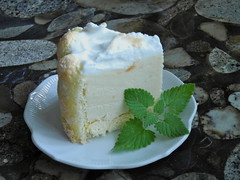 Tasting results: My brother thought the ratio of ladyfingers to filling was skewed too far toward ladyfingers, but we both thought that was a problem of the half-size version, and a 9" cake would be fine. Older niece devoured one of the soufflé dish versions and departed for her homework without comment. Younger niece ate the meringue first because she didn't like it much, then finished the rest with appreciative notes. Nephew thought the ladyfingers were too dry (it was his first encounter with plain ladyfingers, not buried in tiramisù) and left the base uneaten. Personally this is right down my alley, nicely lemony, not too sweet--a lovely dessert.
Tasting results: My brother thought the ratio of ladyfingers to filling was skewed too far toward ladyfingers, but we both thought that was a problem of the half-size version, and a 9" cake would be fine. Older niece devoured one of the soufflé dish versions and departed for her homework without comment. Younger niece ate the meringue first because she didn't like it much, then finished the rest with appreciative notes. Nephew thought the ladyfingers were too dry (it was his first encounter with plain ladyfingers, not buried in tiramisù) and left the base uneaten. Personally this is right down my alley, nicely lemony, not too sweet--a lovely dessert.

